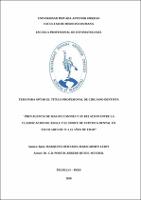Mostrar el registro sencillo del ítem
Prevalencia de maloclusiones y su relación entre la clasificación de Angle y el índice de estética dental en escolares de 12 a 16 años de edad
| dc.contributor.advisor | Portocarrero Reyes, Weyder | |
| dc.contributor.author | Marquina Hurtado, Maricarmen Leidy | |
| dc.creator | Marquina Hurtado, Maricarmen Leidy | |
| dc.date.accessioned | 2020-03-12T15:27:35Z | |
| dc.date.available | 2020-03-12T15:27:35Z | |
| dc.date.issued | 2020 | |
| dc.identifier.uri | https://hdl.handle.net/20.500.12759/6148 | |
| dc.description.abstract | El presente estudio tuvo como objetivo determinar la prevalencia de maloclusiones y su relación entre la clasificación de Angle y el índice de estética dental en escolares de 12 a 16 años de edad de la Institución Educativa Parroquial “JOSE EMILIO LEFEBVRE” del distrito de Moche – Perú 2019. MATERIALES Y MÉTODOS: El estudio prospectivo, transversal, descriptivo, observacional y prolectivo incluyó un total de 145 escolares entre ellos 71 hombres y 74 mujeres. Para evaluar la prevalencia de maloclusiones se empleó la clasificación de Angle y el Índice de estética dental (DAI). Para determinar la relación entre la clasificación de Angle y el DAI, se recogió la información que fue procesada por tablas estadísticas utilizando el coeficiente de correlación Rho de Spearman, lo cual se consideró un nivel de significancia del 5%. RESULTADOS: Los resultados obtenidos mostraron que existe relación significativa entre clasificación de angle y DAI (p<0.001), también se encontró relación significativa con respecto a edad en los estudiantes de 12 a 14 (p=0.023) y con respecto a género en los estudiantes de sexo femenino (p=0.015). CONCLUSIÓN: Los resultados nos permiten concluir que existe relación entre la clasificación de Angle y el DAI, podemos afirmar también que existe relación con respecto a la edad en los estudiantes de 12 a 14 años y respecto al género en los estudiantes de sexo femenino. | es_PE |
| dc.description.abstract | The objective of this study was to determine the prevalence of malocclusions and their relationship between the angle classification and the index of dental aesthetics in schoolchildren aged 12 to 16 years of the “JOSE EMILIO LEFEBVRE“ Parish Educational Institution of the Moche – Trujillo 2019. MATERIALS AND METHODS: The prospective, cross-sectional, descriptive, observational and prolective study included a total of 145 schoolchildren including 71 men and 74 women. To evaluate the prevalence of malocclusions, the Angle classification and the Dental Aesthetic Index (DAI) were used. To determine the relationship between the Angle classification and the DAI, the information that was processed by statistical tables was collected using Spearman's Rho correlation coefficient, which was considered a significance level of 5%. RESULTS: The results obtained showed that there is a significant relationship between angle classification and DAI (p <0.001), a significant relationship was also found regarding age in students from 12 to 14 (p = 0.023) and with respect to gender in students of female sex (p = 0.015). CONCLUSION: The results allow us to conclude that there is a relationship between the Angle classification and the DAI, we can also state that there is a relationship with respect to age in students from 12 to 14 years and with respect to gender in female students. | en_US |
| dc.description.uri | Tesis | es_PE |
| dc.format | application/pdf | es_PE |
| dc.language.iso | spa | es_PE |
| dc.publisher | Universidad Privada Antenor Orrego | es_PE |
| dc.relation.ispartofseries | T_ESTO_629 | |
| dc.rights | info:eu-repo/semantics/closedAccess | es_PE |
| dc.rights.uri | https://creativecommons.org/licenses/by/4.0/ | es_PE |
| dc.source | Universidad Privada Antenor Orrego | es_PE |
| dc.source | Repositorio Institucional - UPAO | es_PE |
| dc.subject | Maloclusiones | es_PE |
| dc.subject | Clasificación de Angle | es_PE |
| dc.subject | Indice de estética dental | es_PE |
| dc.title | Prevalencia de maloclusiones y su relación entre la clasificación de Angle y el índice de estética dental en escolares de 12 a 16 años de edad | es_PE |
| dc.type | info:eu-repo/semantics/bachelorThesis | es_PE |
| thesis.degree.level | Título Profesional | es_PE |
| thesis.degree.grantor | Universidad Privada Antenor Orrego. Facultad de Medicina Humana | es_PE |
| thesis.degree.name | Cirujano Dentista | es_PE |
| thesis.degree.discipline | Estomatología | es_PE |
| dc.subject.ocde | https://purl.org/pe-repo/ocde/ford#3.02.14 | |
| renati.type | https://purl.org/pe-repo/renati/type#tesis | |
| renati.level | https://purl.org/pe-repo/renati/level#tituloProfesional | |
| renati.discipline | 911016 | |
| dc.publisher.country | PE | es_PE |
Ficheros en el ítem
Este ítem aparece en la(s) siguiente(s) colección(es)
-
Estomatología [601]


